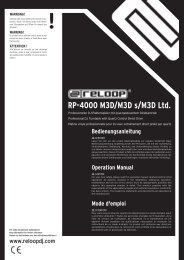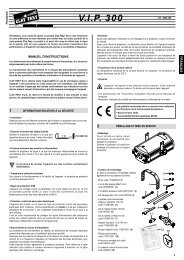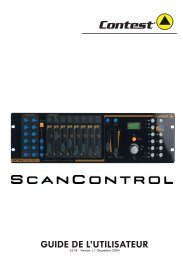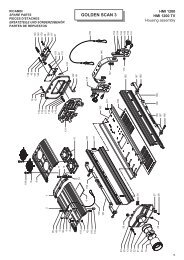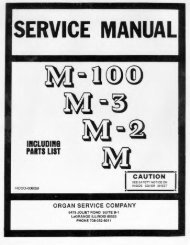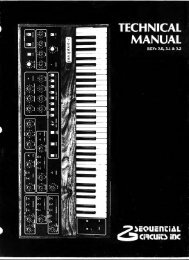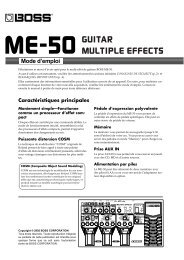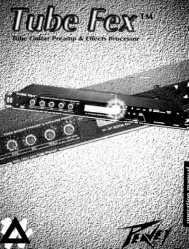Create successful ePaper yourself
Turn your PDF publications into a flip-book with our unique Google optimized e-Paper software.
300 V 3.0 <strong>Owner's</strong> <strong>Manual</strong><strong>Lexicon</strong>Stereo Adjust EQ and Spatial PageBASS (Bass EQ)BASS is a 6dB/octave shelving EQ control with a range of +6 dB boost and -18dBcut. It moves in .50 dB steps from +6 to -6 dB. The crossover point is adjustedwith BXOV. BASS acts on both stereo channels equally.TREB (Treble EQ)TREB is a 6 dB/octave shelving EQ controls with a range of +6 dB boost and-18dB cut. It moves in .50 dB steps from +6 to -6 dB. The crossover point isadjusted with TXOV. TREB acts on both stereo channels equally.LTRB and RTRBThese controls allow independent adjustment of left and right treble. They maybe used together with the stereo adjustments to create a 12 dB/octave cut orboost. Note that the 3 dB frequencies can be different from the stereo set.BXOV (Bass Crossover)BXOV sets the crossover point for BASS. When BASS is set to full cut, the levelis -3 dB at the frequency set with BXOV.TXOV (Stereo TrebleCrossover)TXOV sets the crossover point for TREB. When TREB is set to full cut, the levelis -3 dB at the frequency set with TXOV.TXLR (IndependentTreble Crossover)TXLR sets the crossover point for LTRB and RTRB. When either is set to fullcut, the level is -3 dB at the frequency set with TXLR.SPEQ (Spatial EQ)SPEQ sets the amount of a crossfeed between channels. The signal first goesthrough a 6 dB/octave low-pass filter whose frequency is set with BXOV.When SPEQ is set positive (above 0) the crossfeed has a negative sign. WhenSPEQ is set negative (below 0), the crossfeed has a positive sign. When thecontrol is set to either maximum or minimum, the gain in the crossfeed circuit isunity.The result of this control is to change the separation of low frequency stereosignals. When the control is raised, low frequencies in the sum (mono) channelare reduced, and low frequencies in the difference (stereo) channel are raised.With the control at maximum, low frequency mono signals are completelyremoved. This represents an extreme setting which should seldom be neededin practice.With material which has stereo bass information, or which contains somereverberation, the effect of raising SPEQ is to increase the sense of spaciousnessand depth of the sound. It is particularly useful on material recorded withpanpots, or coincident and semi-coincident microphone technique.When most of the bass in a recording is in the sum (mono) channel, raisingSPEQ may reduce the bass level. This effect can be compensated for by raisingthe overall bass level with BASS. Since both controls use the same BXOVsetting, this compensation will be quite accurate as long as SPEQ is set to lessthan 3 dB boost.4-20





